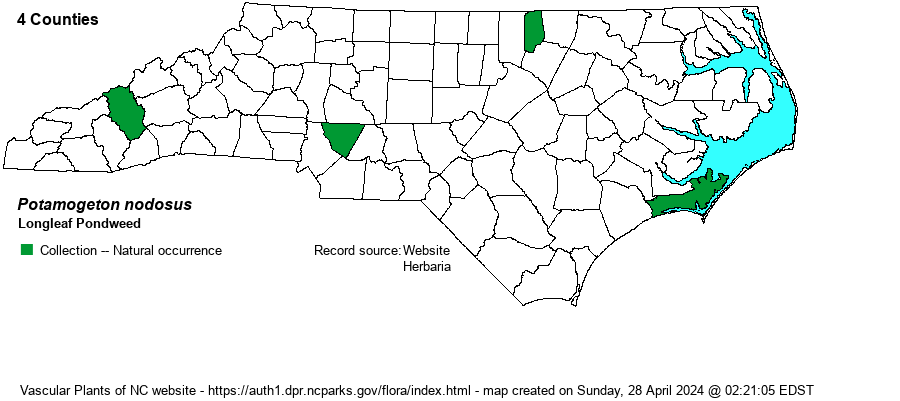| Author | Poiret | |
| Distribution | A few widely scattered records over the state; though SERNEC shows records from nine counties in the state, a detailed examination of specimens by Jame Amoroso at the NCNHP in 2022 indicates that most specimens are misidentified or are simply "indeterminate" as to which Potamogeton species they are. At any rate, there is absolutely no geographic pattern in the state, with each county where recorded lying many additional counties away from any other county where recorded!
This is a very widespread species across North America, from southern Canada south to northern FL, southern TX, and all of CA.
| |
| Abundance | Very rare (and difficult to identify as well). The NCNHP database shows a record from Haywood County as being the most "current" -- 1999. The NCNHP has recently (Feb 2022) changed the State Rank from SH to S1 with the assumption that the species is likely still present in NC. This is a Significantly Rare species, as designated by the NCNHP. | |
| Habitat | This is a species of still to slow-moving waters of ponds, lakes, streams, and rivers. Waters can often be rather deep, up to nearly 6' deep. |
| Phenology | Flowers and fruits from May to September. | |
| Identification | This is a robust species of pondweed, with a potentially tall stature (underwater), reaching to 5-6 feet long, and highly branched. The submersed leaves are quite thin but large, with the blades from 4-6 inches long and about 3/4-inch wide, narrowly elliptical in shape, but with the blade tip not sharp-tipped (as in P. illinoensis). The blade has 7-15 nerves. The petioles of these leaves are very long, often 4-5 inches long. The normally present floating leaves are large, as well, about 3-4 inches long and 1 inch wide, elliptical; their petioles are also quite long, up to 6 inches long. The spikes are dense, rather large at 1.5-2 inches long, and cylindrical in shape; they are normally conspicuous above the water surface, being held erectly or ascending. As mentioned above, P. illinoensis, limited in NC to just a few coastal impoundments, is quite similar but has the submerged leaves with a distinctly sharp tip to the leaves. | |
| Taxonomic Comments | None
| |
| Other Common Name(s) | Knotty Pondweed, American Pondweed, Loddon Pondweed | |
| State Rank | S1 | |
| Global Rank | G5 | |
| State Status | SR-D | |
| US Status | | |
| USACE-agcp | OBL link |
| USACE-emp | OBL link |

